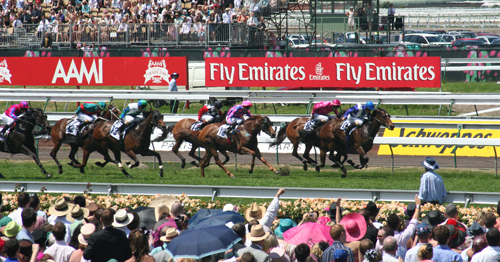 FRIDAY FORUM
FRIDAY FORUM
YOUR VIEWS ON THE NEWS
Last Tuesday, as part of the Spring Racing Carnival, the Melbourne Cup was run for the 156th time. It is touted as “the race that stops the nation” but perhaps it is time for the nation to stop this race (and others).
Let’s put aside the ethical issues about gambling and its increasing legitimisation (what does “gamble responsibly” really mean?) and consider what racing does to our horses.
The racing industry is huge; approximately 15,000 thoroughbred foals are bred each year, with about the same number bred overseas.
Training begins at two years, which is a risk in itself. The young horse’s skeletal system is still immature at this age, and not ready for the physical stress of racing. Those thought to have potential are often subjected to gruelling training regimes, which can mean physical and mental injuries. In the races themselves, whips are still used, and the risk of fatal injury is high.
Most racing horses are individually stabled for much of the day, which isolates them socially, and inhibits environmental stimulation. Some stabled horses resort to crib-biting (biting on fixed objects, then pulling back, causing a condition called wind-sucking) and self-mutilation, both indicative of stress.
Horses are fed grain during training, which often leads to gastric ulcers. One study found that 89 per cent of race horses at Randwick had stomach ulcers. There is no reason to assume the number would be lower in Victorian racing stables.
Racing is profit driven; horses that do not make the grade (ie are too slow and therefore not profitable) are usually sent to slaughterhouses, either to local ones to become pet food, or to two horse abattoirs where they are killed, and exported overseas (2000 tonnes a year) to Japan and Europe, for human consumption. According to Animals Australia, over 25,000 horses per year are killed.
As I make my way out of Flinders Street Station, a poster of racing horses with the caption ‘hearts pounding’, flaps overhead. The cruel irony of this is that a horrific outcome of racing is the medical condition EIPD: Exercise-Induced Pulmonary Haemorrhage. A 2005 study carried out by the University of Melbourne found that 50 per cent of race horses had blood in their windpipes, and 90 per cent had blood in their lungs.
Last year, one of the Melbourne Cup favourites, Red Cadeaux, broke his left foreleg on the track, and was later euthanised. In the previous year, Admire Rakti died after the finish line, from heart failure, and another horse, Araldo, was euthanised later because of a leg injury.
These are only the high-profile horses; according to the Coalition for the Protection of Racehorses, 127 race horses died, or were pronounced dead, on race tracks during 2014-2015.
Why aren’t we better informed about these statistics? Why are we allowing these cruel practices to continue? I haven’t even addressed the subject of jumps racing, which attracts 20 times more fatalities than flat races.
It is interesting to note that some sections of the media are reporting the cruelty, including The Australian Women’s Weekly and SBS.
The Australian Women’s Weekly reported that social media posts indicate an increase in the number of Australians turning away from such cruelty, realising that a three-minute race could well mean the end of a racehorse’s life.
On Tuesday, SBS on their news site The Feed, produced their own race/betting guide, working out which Melbourne Cup horse had the best odds of being euthanised. This was their way of informing viewers about the dangers of horse racing.
The original definition of ‘carnival’ was ‘a festival of merrymaking before the season of Lent.’ Maybe when the Spring Racing “Carnival” finishes this weekend we need a period of contemplation, hopefully leading to repentance, reflection … and protest.
Let us be the nation that stops the races.
‘Not to hurt our humble brethren is our first duty to them,
but to stop there is not enough.
We have a higher mission-
to be of service to them wherever they require it.’
-St Francis of Assisi
Rev Barbara Allen
Spirituality and Creation Project Worker
On this week’s Friday Forum: What hope is there of stopping the cruelty behind the racing industry?
For more information:
Animals Australia: http://www.animalsaustralia.org/issues/horse_racing.php
Coalition for the Protection of Racehorses: https://www.horseracingkills.com/


Comments are closed.